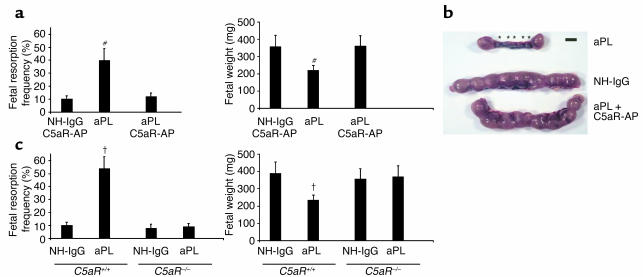Figure 5.
Blockade of C5a-C5aR interaction protects pregnancies from aPL Ab–associated injury. (a and b) Pregnant BALB/c mice were given aPL-IgG (10 mg, intraperitoneally) or NH-IgG (10 mg, intraperitoneally) on days 8 and 12, and some also received C5aR antagonist peptide (C5aR-AP) (50 μg, intraperitoneally) on day 8, 30 minutes before administration of aPL-IgG (n = 5–11 mice/group). Pregnancy outcomes were assessed as described in the legend for Figure 1. Treatment with C5aR-AP prevented fetal loss and growth inhibition. #P < 0.01, aPL versus aPL plus C5aR-AP. (b) Uteri from day 15 of pregnancy. There are two small amnion sacs and five resorptions (*) in the uterus from an aPL-IgG–treated mouse, while the uterus of a mouse that received aPL-IgG along with C5aR-AP contained normal size amnionic sacs and no resorptions, similar to that from a mouse treated with NH-IgG. Data are representative of observations in five to seven mice in each experimental group. Scale bar: 1 cm. (c) The effects of effects of aPL-IgG on pregnancy outcomes in C5aR–/– and C5aR+/+ mice were compared (n = 5–11 mice/group). Pregnant mice were treated with aPL-IgG or NH-IgG as described above. C5aR–/– mice were protected from aPL-IgG–induced fetal resorption and growth inhibition. †P < 0.05, aPL-IgG versus NH-IgG.

